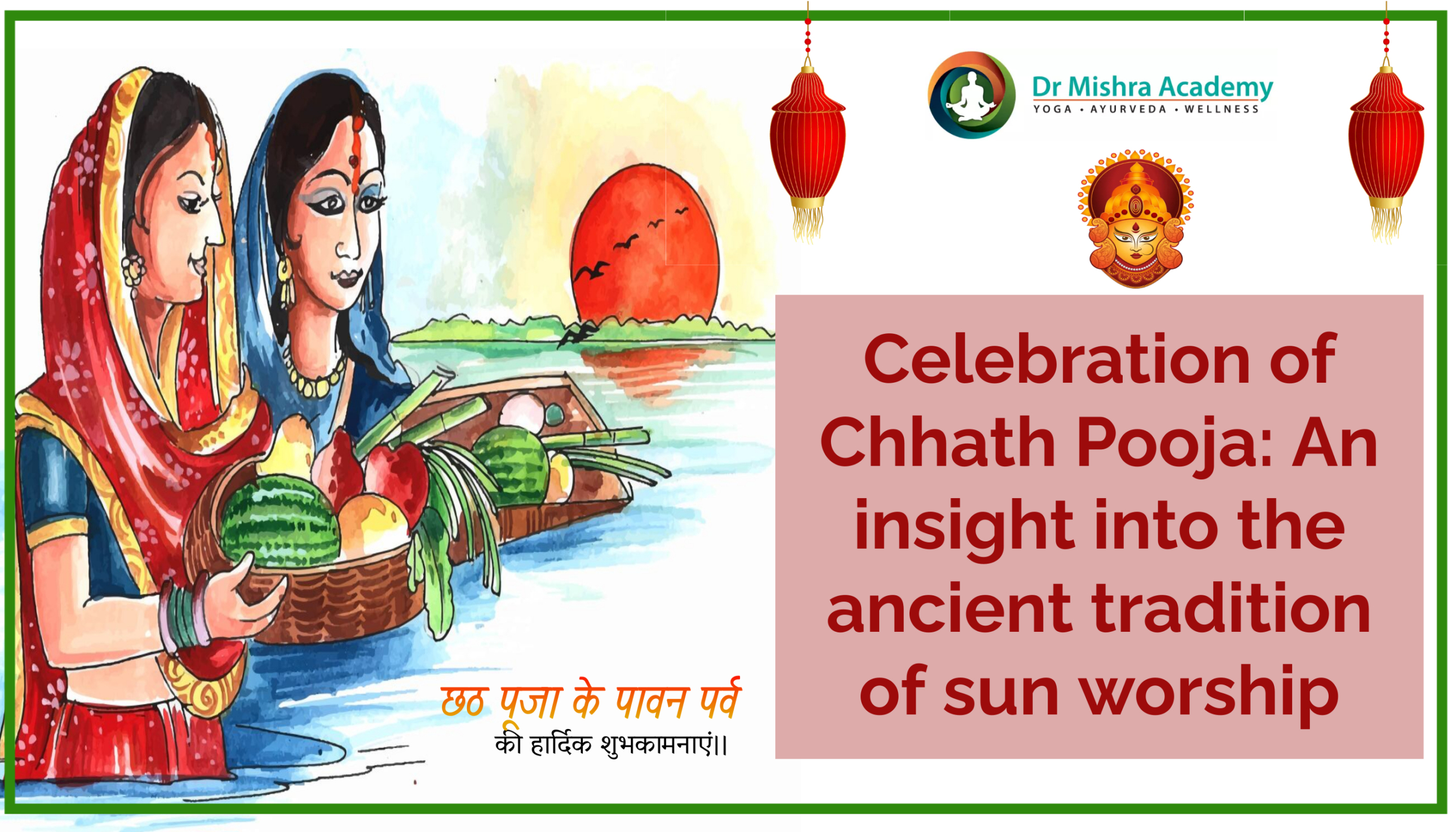Celebration of Chhath Pooja: An insight into the ancient tradition of sun worship

Celebration of Chhath Pooja An insight into the ancient tradition of sun worship
India is famous for its rich variety of festivals and traditions, each reflecting its rich cultural heritage and spiritual depth. One such ancient festival that stands out is Chhath Pooja; also known as Chhath Parv or Dala Chhath in North India. Devotees pay their respects to Surya as the Sun God and Chhathi Maiya as the Goddess of Energy through this auspicious event that fosters family bonds while cultivating devotion to Chhathi Maiya as energy goddess. We will explore its rich history, rituals significance regional variations as well as present-day significance through an in-depth study that offers all relevant details of Chhath Pooja in detail.
History of Chhath Pooja
Chhath Pooja can be traced back to Vedic times, making it one of the oldest living Hindu festivals. The word “Chhath” comes from Sanskrit word Shashthi”, meaning six and refers to day six in Kartik lunar month when this festival takes place; according to Gregorian calendar this day usually falls during October/November and marks transitioning from autumn into winter season.
Chhath Pooja can be traced back to its origins in the Rigveda, one of Hinduism’s oldest sacred texts. Hymns in Rigveda pay homage to Surya as the source of life, energy, and vitality; over time this reverence for Surya led to an all-embracing festival with profound spiritual meaning.
Historical records indicate that Chhath Pooja as we know it has been celebrated since at least the Maurya Empire (322 to 1885 BC), when Chandragupta Maurya and his successors celebrated it. Additionally, Draupadi (Queen of Pandavas) performed Chhath pooja to address her challenges as mentioned in Mahabharata.
Chhath Pooja Rituals:
Chhath Pooja, or the four-day festival that requires strict discipline and devotion from participants, requires rigorous rituals that span four days. While predominantly performed by women, men also actively take part. Here is an insight into its most essential rituals:
Nahai Khai (Day 1):
The festival commences with believers taking a ritual bath in a holy river or pond before sunrise, cleaning their homes and utensils before feasting upon a simple meal that does not include onion and garlic – it marks their last food intake before fasting begins for 36 hours.
Kharna (Day 2):
On the second day, devotees observe a strict 36-hour fast without water. At sunset, they prepare the offering (prasad), consisting of sweet rice pudding (kheer) and chapatis (unleavened bread). This prasad will be given as thanksgiving to the setting sun.
After offering, devotees break their fast by eating prasad (divine food).
Sanjhiya Arghya (Day 3):
Devotees fast for another day without water and continue their rituals, gathering at rivers and ponds each evening to make offerings of fruit, sugar cane stalks, flowers and other traditional items to the setting sun.
Worshippers offer prayers of thanks to the sun god by lighting earthen lamps atop floating banana leaves and then placing them into the water as an offering.
Paarun (Day 4):
On the final day of Chhath Pooja, devotees take another ritual bath before sunrise in another ritual bath rite known as Chhath Bathing, standing waist deep in water as they offer prayers to the rising sun for blessings that will ensure well-being and prosperity of their families.
After performing all necessary rituals, participants break their fast and conclude the Chhath Pooja festival.
Meaning of Chhath Pooja
Chhath Pooja holds great meaning for people living in Northern India and those who follow its traditions, with some key aspects being:
Sun Worship: Its Chhath Pooja is an annual ceremony to pay our utmost respects to the sun – our life-giving source on this planet – by paying homage to it as God, hoping it will bring health, wealth, and longevity in return. Devotees believe they can attain these blessings by paying respect to him.
Harvest Festival: Chhath Pooja, as an annual harvest festival, expresses thanks for the abundant harvest while celebrating agriculture as the source of livelihood. Farmers use this festival as an opportunity to seek divine protection and ensure an outstanding agricultural season.
Family and Community Cohesion: Chhath Pooja brings families and communities closer together, cultivating feelings of unity, love, and mutual support. Participants fast together while performing rituals aimed at strengthening both familial and communal bonds.
Cultural Heritage: This festival forms an essential part of North India’s rich cultural legacy and plays a pivotal role in maintaining traditional customs and rituals as well as offering insight into cultural identity and religious practices of its region.
Environmental awareness: Biodegradable offerings cast into rivers and ponds demonstrate our respect for nature while reminding us to protect water bodies.
Regional Variations of Chhath Pooja:
Chhath Pooja is traditionally observed across northern India; however, its celebration varies according to different states and communities due to customs and traditions that add depth and variation into this festival:
Bihar:
Bihar is at the epicenter of Chhath Pooja celebrations and this festival is celebrated with great fervour here. Devotees typically travel to banks of Ganges or other water bodies for rituals which feature strict adherence to tradition and detailed attention paid towards performing them. Uttar Pradesh: In Uttar Pradesh, Chhath Pooja celebrations can also be found with great gusto. Devotees visit places such as Ganga for Pooja rituals as this event marks another festival celebrated throughout this region with great enthusiasm as part of Chhath Pooja festival festivities.
Uttar Pradesh:
Uttar Pradesh celebrates Chhath Pooja with devotion on an enormous scale with devotees gathering along the banks of Yamuna River as well as other rivers and ponds, drawing together to worship this festival that blends traditional customs with regional variations. W. Bharkhand offers similar celebrations.
Jharkhand:
Jharkhand, which formerly belonged to Bihar, has an established tradition of Chhath Pooja and devotees perform the rituals with great enthusiasm and devotion across different regions of the state.
Nepal:
Chhath Pooja can also be observed in some regions of Nepal such as Terai.
While many of the core rituals remain the same, Nepalese devotees have their own distinctive ways of commemorating this festival.
Global Celebration of Chhath Mahaparv- Chhath Pooja
Chhath Mahaparv – Chhath Pooja is one of the most widely celebrated festivals in the world, with strong traditions in countries like Germany. It is also celebrated in countries like Britain, Canada, Dubai and Abu Dhabi UAE UAE Philippines Australia USA Canada Germany.
Dr. Rajesh Mishra-Shaktya e.V. was given an unprecedented opportunity to organise Chhath Mahaparv – Chhath Pooja event in 2022, in collaboration with other organisations, which was widely celebrated. Shaktya e.V.’s pioneering efforts in promoting cultural diversity and inclusivity were showcased with this momentous event in Bremen, Germany.
Significance of Chhath Pooja:
Chhath Pooja continues to play an integral part in cultural preservation despite modernisation and changing lifestyles, for several reasons:
Cultural Preservation: Chhath Pooja serves a vital purpose of passing down cultural heritage from generation to generation in North India, serving as a powerful reminder of its rich traditions that make up its identity and have helped shape its character.
Community Harmony: This festival fosters communal harmony by gathering people of various backgrounds together for celebration and fun. It transcends religious boundaries to foster unity among different communities.
Environmental Awareness: Chhath Pooja’s eco-friendly nature stands as an example of responsible environmental practices. Utilising biodegradable materials during rituals shows a harmonious coexistence with nature.
Spiritual Rejuvenation: Chhath Pooja provides individuals the chance to reconnect with their spiritual roots and find solace through devotion. The rituals encourage introspection and mindfulness.
Conclusion:
Chhath Pooja stands as an incredible testament to India’s longstanding traditions, spirituality, and unity. Originating in ancient Vedic practices, this festival continues to thrive and change with each passing year without losing its core identity. Offering insight into the worship of the Sun God as well as the intimate connection between man, nature, and spirituality; devotees gather at riverbanks or ponds on all four corners of India each day from sunrise until sundown for prayer offerings to rising/setting Sun and culture celebration – Chhath Pooja remains vibrant and beloved celebration that connects past and present while simultaneously cultivating a sense of continuity and deep spiritual bonding between generations.


